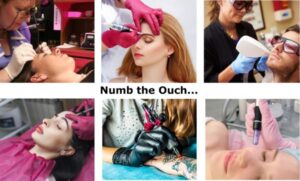 Topical anesthetics are crucial in numbing the skin and relieving pain for various medical and aesthetic procedures.
Topical anesthetics are crucial in numbing the skin and relieving pain for various medical and aesthetic procedures.
However, it can be frustrating to encounter situations where a topical anesthetic doesn’t work. In this article, we will explore why your topical anesthetic may not be as effective as expected and provide insights on maximizing its effectiveness.
Benefits of Using Topical Anesthetic Creams
Before discussing why your topical anesthetic may not work, let’s first understand what it is and how it works. Topical anesthetics are medications applied to the skin to numb the area and relieve pain. They work by blocking the nerve signals in the skin, preventing them from reaching the brain and causing pain. These anesthetics come in various forms, such as creams, gels, sprays, and patches. They can be purchased online, over the counter, or prescribed by a doctor.
Reasons Your Topical Anesthetic May Not Work
Formulation: The choice of topical anesthetic formulation is essential for effective results. Different formulations (cream, gel, ointment, spray, etc.) have varying abilities to penetrate the skin and deliver the active ingredients to the target area.
Base Ingredients: The base or carrier ingredients used in the topical anesthetic can influence its effectiveness. Some bases may enhance absorption, while others may hinder it.
pH Level: The pH of the topical anesthetic should be compatible with the skin’s pH to prevent irritation and enhance absorption.
Technique of Application: The skill and technique of the person applying the topical anesthetic can impact its effectiveness. Proper and uniform application is essential.
Skin Type: Thicker, harder, or drier skin may require more time for the anesthetic to penetrate and take effect. Conversely, abrading the skin excessively before applying anesthetic should be avoided. This can create raw skin, making it easier for the anesthetic to penetrate deeper and potentially reach the bloodstream.
Skin Oiliness and Cleanliness: Oily or obstructed skin may repel anesthetic creams. Proper preparation by removing particulate matter, cosmetics, and excess natural oils before applying a topical anesthetic is essential for optimal absorption and effectiveness.
Duration of Application: The time the anesthetic is applied can impact its effectiveness. Too short a duration may not provide sufficient numbing, while leaving it on too long may result in reduced efficacy or wearing off before the procedure begins.
Understanding the recommended application time for the specific product is crucial.
Skin Preparation: Properly preparing the skin by cleaning and, in some cases, exfoliating or degreasing it can improve the absorption and effectiveness of the anesthetic.
Temperature: The skin’s temperature can affect the anesthetic’s absorption. Some products may require time to warm to skin temperature for optimal absorption.
Anatomical Location: Different body areas may have varying absorption rates due to differences in skin thickness and vascularity.
Application Surface Area: Larger treatment areas may require more careful consideration to avoid reaching toxic blood serum levels. Segmenting and treating large areas in successive sessions can reduce this risk.
Patient Factors: Patient-specific factors, such as age, overall health, and medical conditions, can influence the effectiveness of the topical anesthetic.
Patient’s Sensitivity: Some individuals may naturally be more or less sensitive to pain, influencing their perception of the anesthetic’s effectiveness. Also, a theory in the anesthetic community suggests that natural redheads may require more anesthetic due to a receptor on certain cells that normally provide pigment to people’s skin and hair. In red-headed individuals, this receptor does not function properly. There are many articles on this. Natural Redheads May Need More Anesthesia
Patient’s Expectations: A patient’s expectations and mindset can affect their perception of pain and the effectiveness of the anesthetic.
Interaction with Other Medications: If a patient takes other medications or uses topical products that may interact with the anesthetic, it can affect its efficacy.
Pre/Co-Existing Pain: Patients with existing medical conditions that cause pain may be more sensitive to additional sources of pain. Long-term analgesic use can also affect the efficacy of topical anesthetics.
Menstrual Status (for Female Patients): Hormonal changes during menstruation may increase a female patient’s sensitivity to pain, so this should be considered when planning aesthetic procedures.
Mental State of the Patient: Patients who are anxious, stressed, hurried, or emotionally upset may experience heightened sensitivity to pain. A calming and confident practitioner can help alleviate patient anxiety and improve their overall experience.
Technique and Manner of the Technician: The skill and demeanor of the technician performing the procedure play a significant role in patient comfort. A skilled and confident technician can help reduce anxiety and improve the overall experience.
In summary, while the concentration of active ingredients is an important factor, the effectiveness of a topical anesthetic is influenced by a complex interplay of various factors, including formulation, skin characteristics, application technique, and patient-specific factors. A holistic approach to considering these factors is necessary to ensure the desired level of anesthesia in aesthetic procedures.
Most importantly, always follow the directions that come with the product, found in or on the box for the best results.



